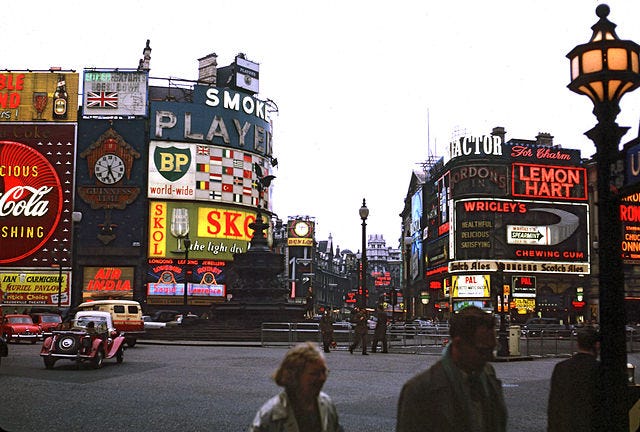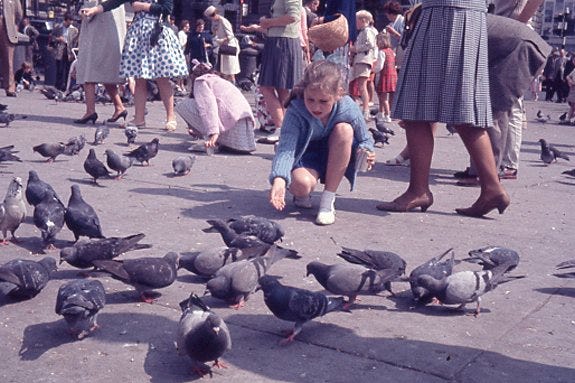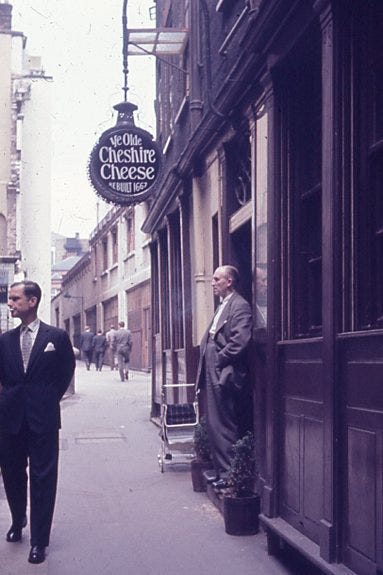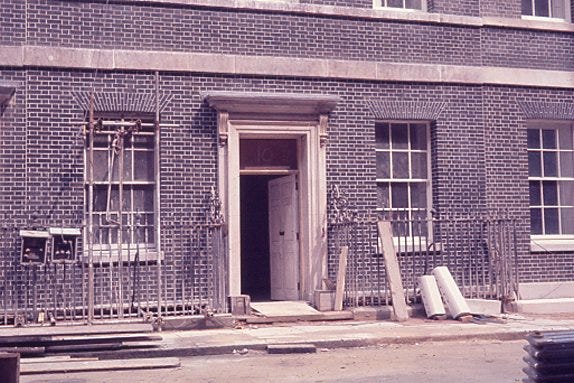Mon. Aug. 5
Our first day in London—it is Bank Holiday so all shops are closed. We walked from our hotel to Whitehall to see the Changing of the Horse Guards. Because of the beautiful black horses it was interesting—but not as much activity as the time I saw the changing of the guards at Buckingham.
The King’s Life Guard are mounted troops who stand guard at the official entrance to St. James’s and Buckingham Palaces. The ceremony of changing the guard at Horse Guards Parade has remained much the same since the Restoration of King Charles II in 1660. Here’s one of K’s slides from her visit.
On our way back we stopped at Westminster Abbey and spent some time there. We did see the poets’ corner, but there was such a crowd we did not see all of it. Part of the time there was one-way traffic. It is a chance to be in this area. Before—at Marble Arch—it was a commercial district.
Poet’s Corner at Westminster Abbey is the resting place of over 100 poets and writers.
We came back to the hotel and had lunch—but lunch at any hotel seems to turn out to be a dinner.
We had tickets—which we ordered this a.m.—for the musical “Oliver.” It was a 4:30 p.m. matinee. We had center seats in the very front row. It is, of course, based on Oliver Twist—but my knowledge of Dickens is very limited. It was fun. There are many children in it besides Oliver, and they were cute.
The stage musical Oliver! opened at the New Theatre (now the Noël Coward Theatre) in London on 30 June 1960 and ran for a record-breaking 2,618 performances. Here’s the original program cover, and the link to a list of the cast.
Quite a few people had tea served during the intermission—and it was quite a meal—but it was too near the time we had eaten.
The show was over at 7:00 p.m. and we walked to Piccadilly Circus. Stopped in a hotel where Helen & Liz had stayed, and were glad we are where we are.
Piccadilly Circus is a space in London’s West End that is similar to Times Square in New York. Here’s a 1962 picture of the area.
We started out to walk to Trafalgar Square, but cited the wrong monument so ended at a dead end and the foreign offices. Could see the shaft at Trafalgar Square but would have had to go a long way round—so took a cab back to the hotel. It is now about 9:00 p.m. The dining room opens at 9:30 for cold suppers so we will go down then.
I looked at a map and could see that they must have headed toward the Cenotaph, a war memorial near the government offices, rather than Nelson’s Column, a monument in Trafalgar Square.
Tuesday, Aug. 6
Another pleasant day of weather. This morning we sent to the U.S Lines to get our boat train tickets, check in, etc. Then we went to Cooks to buy our tickets for Bath, which I want to see. We’ll do it in one day—tomorrow.
Here’s one of K’s street shots from this London visit that I think is just adorable.
Our next stop was Samuel Johnson’s house. Guess he made the first dictionary. The first edition—in two large volumes—was there. We could handle and look at it. Guess one definition often quoted is “Oats—a grain used for horses in England but supports the people in Scotland.” That spot in the dictionary was so worn they had put transparent tape over it. Some of the definitions were much more erudite.
Samuel Johnson (1709-1784) was an influential English writer and literary critic. Although his 1755 “A Dictionary of the English Language” was not the first English-language dictionary, it was by far the most comprehensive. It is considered a significant advance in lexicography, incorporating literary quotations to illustrate the meaning of words, notes on usage, and multiple definitions. The London house where he compiled the dictionary, now called Dr Johnson’s House, is a museum and home to a foundation that honors his life and works. I found it very interesting to hear that they could handle the dictionary—I’m pretty sure that’s no longer the case!
We went through the house—four stories of it, but not a large floor area. From there we walked to the Cheshire Cheese. The lady in charge said “two minutes if we walked slowly, one if we hurried.” It is old—goes back to at least Johnson’s time. Had a good meal—meat pie (meat, kidney, game)—then we walked a while on Fleet Street.
Ye Olde Cheshire Cheese is a historic London pub—it was rebuilt after the Great Fire of 1666 and is still in operation today. Here’s a picture K took on her visit.
Then a cab to Bond Street. We walked to Regent Street and Liberty’s. I spent my time in the materials but resisted! Couldn’t see much I could send under $10.00, and I have to figure up just how much I have left to spend. But I drooled at the beautiful things.
Liberty London is a luxury department store established in 1875. Among other things, they are known for their fabrics, including “lawn,” a lightweight, tightly woven, high thread count cotton fabric with a smooth, silky, crisp texture, which they offer in a wide range of designer patterns. K loved to sew, so this must have been quite a feast for her senses!
A little more walking and we came back to the hotel. I’ve done a washing of me and my clothes. Soon I’ll need to dress for tea. We had such a big lunch we’re not going to eat a big dinner. We (Bertha & I) have tickets for Mary, Mary. Helen and Liz will see an Agatha Christie mystery, The Mouse Trap that has run 11 years! It was here when they were here 7 years ago but they didn’t see it.
The Mousetrap is a murder mystery play written by Agatha Christie that opened in London’s West End in 1952. Other than a hiatus during COVID, it has run continuously since then and recently reached its 30,000th performance.
At Dr. Johnson’s house, the young couple who were there signed the register as being from Gladwynne (sp?). Rev. and Mrs.—someone— I spoke to them but they were not too communicative. They were young—I wondered if it was a honeymoon.
Gladwyne, PA is a town near Swarthmore, where K’s sister Ruth (to whom these travel letters were written) was living.
Number 10 Downing Street
I’ll close this entry with a picture K took sometime during her London trip. This is the front door of Number 10 Downing Street, the official residence and office of the prime minister of the UK. It was undergoing extensive renovations at that time, and the prime minister, Harold Macmillan, was living at nearby Admiralty House.
I hope you’ve enjoyed this installment of Travels with K! If you know someone who might enjoy it, please feel free to share.










